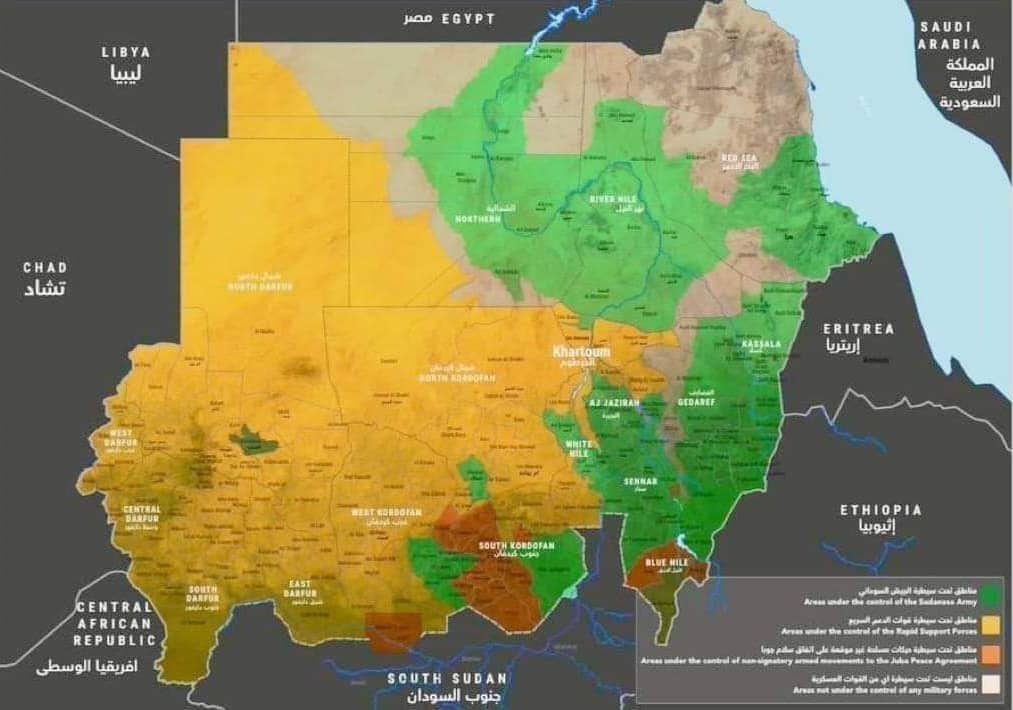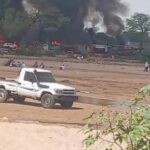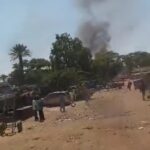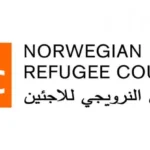Darfur follow-ups
Since fighting first broke out between the Sudanese Armed Forces (SAF) and paramilitary Rapid Support Forces (RSF) on 15 April, darfur follow ups records over 3,466 events of political violence and more than 12,121 reported fatalities in Sudan.
From 3 October to 4 December , darfur follow ups records over 297 political violence events and over 1,417 reported fatalities.
While Khartoum state had the highest number of political violence events, with over 240, West Darfur state had the highest number of fatalities, at approximately 911, and nearly 11 political violence events.
The most common event type was battles, with 155 recorded, followed by explosions and remote violence events, at more than 120. Compared to the previous four weeks, darfur follow ups had been recorded
Although the second round of peace talks was held in the Saudi city of Jeddah from 26 October to 7 November, the RSF continued to advance relentlessly, further consolidating its territorial dominance in Darfur.
By the end of November, the RSF controls four out of five Darfur states. Meanwhile, warring parties continued to fight in Khartoum to control strategic locations and secure an alternative route to connect the three-cities in Khartoum. This report analyzes this fight for access to the three-cities and the conflict dynamics in Darfur.
Sudan’s capital city, Khartoum, is the main battleground of the conflict that has engulfed the country since April. Between 3 October and 4 December , darfur follow ups records 113 battle events in Khartoum – a 18% decrease compared to the preceding four weeks.
Fighting raged in two main areas within the capital city. The first is Shambat bridge, a supply route used by the RSF to link Omdurman with Bahri. The bridge was bombed on 11 November, with both the RSF and the SAF accusing each other of responsibility for the bombing.
However, it is more likely the SAF is behind the bombing of the bridge as it effectively isolated RSF forces in Bahri from those in Omdurman. Moreover, it cut off RSF reinforcements and weapons supplies in Darfur from reaching Bahri and Khartoum, as other bridges in Omdurman are under the SAF control.
A second primary battleground is Jabal Awlia, which serves a strategic function for several reasons.
Jabal Awlia is located south of Khartoum on the east bank of the White Nile river, separating the RSF-controlled Omdurman on the west and the SAF-controlled Air Defense Base in Khartoum on the east and the north of Jabal Awlia, RSF forces housed in the nearby Tayba military base prevent the SAF from advancing towards the besieged Armored Corps base in southern Khartoum, Jabal Awlia bridge also serves as a critical link between Khartoum and Omdurman, potentially offering the RSF an alternative route to reach Khartoum.
Following the bombing of Shambat bridge, the RSF movements were limited between Khartoum’s three-cities because the SAF controlled the west ends of al-Halfaya, al-Fitahab, and White Nile bridges, in addition to the east end of Jabal Awlia bridge linking Omdurman.
Finally, Jabal Awlia hosts the Air Defense base, making it a prized target for the RSF.
The RSF has directed its war efforts towards the base to gain control of both sides of Jabal Awlia bridge and thus secure an access point to Khartoum as an alternative to Shambat bridge. Heightened clashes at the Air Defense base resulted in the bombing of Jabal Awlia bridge over the White Nile on 18 November, a week after the same fate befell the Shambat bridge.
Both the RSF and the SAF blame each other for the bridge’s partial destruction. On 20 November, the RSF overtook the Air Defense base.
Persistent clashes between SAF and RSF have cut off access to entire neighborhoods in Khartoum, Omdurman, and Bahri, leading to severe shortages of food, water, and electricity.
Civilian displacement continues, particularly in Jabal Awlia. Multiple disease outbreaks, including acute watery diarrhea, cholera, measles, dengue, and malaria further compound Sudan’s precarious humanitarian situation, which the United Nations Refugee Agency described as “unimaginable.
The UN Office for the Coordination of Humanitarian Affairs estimates that millions of people lack access to food, water, shelter, electricity, education, health care and nutrition,” including in the capital region which “remains the epicenter of displacement and fighting.
High Tensions in Newly RSF-Controlled Darfur
In November, the RSF continued advancing in Darfur, claiming control of four states .The RSF besieged Darfur’s main urban areas, offering the SAF to surrender and withdraw without fighting.
Mediation initiatives facilitated by native administrations played a crucial role in enabling the fall of Nyala, Zalingei, El Geneina, and El Daein cities to the RSF. Given current limitations in ensuring regular reinforcement and supplies to their troops, the SAF chose to relinquish their bases one after another hitch remains unable to secure reinforcements.

The political dynamic and territorial control of Darfur by RSF
Yet, since the RSF gained control of the majority of Darfur, armed clashes have significantly subsided in RSF-controlled areas, as SAF forces withdrew from Darfur region to Kordofan region.
This shifts the conflict dynamic as RSF now focuses on Kordofan region.The RSF is transitioning to the de facto ruling authority in Darfur, with the RSF leader Mohamed Hamdan Dagalo, known as Hemedti, encouraging local communities to form autonomous governing entities. Despite these efforts, clashes have occasionally erupted between RSF-allied militias, such as the Salamat and Habbaniya ethnic militias, over land ownership disputes. Such continued conflicts raise questions about the RSF’s ability to rein in local ethnic groups and manage inter-ethnic tensions.
Moreover, the RSF has restricted civilians from fleeing to Chad in an effort to indicate that Darfur is safe.
The RSF has reinstated police forces and appointed RSF commanders to lead the captured SAF military bases.However, the looming fear of complete RSF control over Darfur has spurred the formation of new alliances and united previously rival factions.
The mobilization to defend El Fasher has brought together various factions, including those that did not sign the Juba Peace Agreement.
West darfur
While most RSF attacks on SAF garrisons in Darfur lack a discernible pattern of directly targeting civilians based on their ethnic identity, the clashes in West Darfur, particularly in El Geneina, have exhibited an inclination toward ethnically targeting and forcibly displacing the specific tribes. Following days-long clashes with the SAF, the RSF overtook the SAF 15th Infantry Division Headquarters (HQ) in El Geneina city on 4 November.
Subsequently, RSF members raided the city, targeting mostly ethnically Masalit civilians, looting houses, and setting fire to shelters for internally displaced people.
Estimates from several reports indicate these attacks killed between 800 and 1,300 people, including Masalit Farsha – a prominent leader in the Sultanate of Dar Masalit – and nine members of his family.As a result, civilians fled to Chad until the RSF and allied militias closed the border on 8 November.
However, there are doubts, according to the statements on 26 November of the governor of West Darfur, Al-Tijani Al-Taher Karshom, about the accuracy of the figures killed by the events of ardamata in the city of El Geneina, according to reports by human rights organizations, with the killing of 1,300 people, including children, women, and the elderly, and the wounding of more than 2,000 others. He said (it is true that the battle on the first and second days “ in ardamata” was used in Heavy artillery, and it affected citizens in the surrounding neighborhoods, but accurate statistics regarding those killed are difficult to know, but after the situation stabilizes, it is possible to know that, and I do not think that the victims are in these numbers.) Masalit ethnic group is the majority in El Geneina. Historical grievances and land ownership disputes amplify these attacks, further exacerbated by the participation of the Sudan Alliance Movement and the Masalit militia against the RSF, intensifying the complexity of the conflict in previous encounters.
East darfur
In East Darfur, the lone state in the Darfur region that has thus far managed to avoid direct military clashes between opposing factions, a significant local accord has effectively averted hostilities. El Daein city, the capital of East Darfur, is home to the Rizeigat ethnic group, from which several RSF leaders and recruits hail. Rizeigat ethnic militia provides a considerable number of combatants to various fronts in El Daein and other cities throughout Darfur.
However, the RSF’s resolve to assert control over the entire Darfur region prompted a strategic shift to Rizeigat ethnic group’s home territory.
Substantial RSF military reinforcements were dispatched after a sizable force from South Darfur state arrived and positioned itself in Umm Waragat, approximately 30 kilometers west of El Daein, with the intention of attacking the SAF 20th Infantry Division HQ.
Despite the native administration in El Daein seeking to dissuade the RSF from initiating an assault, citing the city’s importance as a residence for numerous RSF leaders and soldiers, clashes erupted around the HQ and El Daein airport on 20 November.
This resulted in the RSF gaining control after the SAF withdrew ، RSF also took control over the 82nd Infantry Division HQ in Adila and the Abu Karinka garrison following the SAF’s withdrawal from the area. Additionally, the RSF seized the Sufyian oilfield in Jad El Seid locality after engaging in clashes with SAF forces. This development signifies a departure from the prevailing trend in East Darfur, where earlier local agreements had effectively maintained the region’s relative immunity from direct military confrontations.
South darfur
Meanwhile, in South Darfur, political violence has decreased in Nyala since the RSF took control of the city on 26 October The RSF has reopened markets and is making efforts to encourage people to resume their lives.Additionally, the RSF has reinstated police forces and appointed commanders for the captured SAF 16th Infantry Division.
Meanwhile, from 12 to 21 November, another round of armed clashes between Salamat and Habbaniya ethnic militias broke out in various locations, including Buram, Nadif, and Marfaeena, stemming from a land dispute.
These two ethnic militias last clashed in August Though not directly related to the wider conflict, this dispute saw the RSF-backed Salamat ethnic militia clashing with Habbaniya forces, allegedly supported by the SAF ، The clashes resulted in 30 people reportedly killed.

North darfur Alliances and Battle for Ultimate Control of Darfur
On 16 November, the RSF announced the formation of joint security forces after a meeting with leaders of the Sudan Liberation Movement-Transitional Council, the Gathering of the Sudan Liberation Forces (GLSF), the Minnawi faction of the Sudan Liberation Movement/Army (SLM/A), and the Justice and Equality Movement.
This announcement challenged the Joint Darfur Rebel groups’ neutral position, causing internal tensions among the members of the joint groups, leading to various leaders announcing their support for the SAF or affirming their neutrality. For instance, following the RSF announcement, the SLM/A-Minnawi faction, Justice and Equality Movement-Gibrel Ibrahim faction, SLM/A-Mustafa Tambour faction, and the political secretary of the GLSF, Salah Hamid al-Wali, declared their intention to fight alongside the SAF against the RSF, abandoning their initial neutrality.
The Joint Darfur Rebel groups, comprising four of the signatories of the 2020 Juba Peace Agreement, were established on 27 April 2023 to ensure the protection of civilians in Darfur.
Furthermore, the non-signatory faction of the Juba Peace Agreement, represented by the SLM-A Abdul Wahid al-Nur under the leadership of Yusif Karjakola, the Chief of Staff, arrived in El Fasher on 24 November. The group’s primary objective was to safeguard displacement camps in the city amid concerns of potential attacks.If clashes involving all these actors erupt in El Fasher, SAF would be the sole beneficiary in this intricate situation.
RSF would confront a large number of rebel groups and might be forced to mobilize more troops from other fronts to this location.
The anticipated intense conflict would likely also have a severe impact on civilians, particularly the Zaghawa community and other displaced non-Arab communities that these new alliances are striving to protect. Meanwhile, the RSF would find themselves stretched and depleted as they contend with multiple fronts in Kordofan and North Darfur.
The next target for the RSF in Darfur appears to be El Fasher, the capital of North Darfur and the hometown of the Zaghawa ethnic group, from which most members of the Joint Darfur Rebel groups hail.
While the RSF seems to avoid direct confrontations with rebel groups, the fear of clashes between the RSF and the SAF in El Fasher has affected the Darfur Joint Rebel groups, leading to tensions and divisions within these groups. As a result, some rebel groups declared support for the SAF, while others affirmed their neutrality.
If the RSF attacks El Fasher, there is a risk of devastating ethnic clashes, similar to what occurred in El Geneina in West Darfur, where the involvement of the Sudan Alliance Movement and the Masalit militia against the RSF worsened the situation, triggering historical grievances and landownership contests.
Even though there is no land ownership contest in El Fasher, if members of the Joint Darfur Rebel groups, as well as Zaghawa ethnic militia, mobilize against the RSF, it will create a complex situation when the RSF and the SAF begin to fight in El Fasher.








